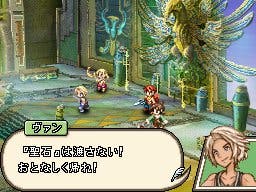Final Fantasy XII: Revenant Wings
Surreal Time Strategy.
Taking place a year after the curtain closed on the first game, this side-story shows Vaan as a fully-fledged sky pirate and mainly takes place in a new location within Ivalice - or technically above it, in the sky world of Lemures.
In the first of the levels we played Vaan was exploring the Glabados Ruins with Penelo. Tapping either character selects them and then pointing to a location elsewhere on the screen sends them toddling off in that direction. Tapping an enemy when one of your characters is selected instigates an attack, although if either Vaan or Penelo are attacked while idly walking somewhere they return fire without any prompting.
Using the stylus it's possible to draw a select box and thereby activate larger groups of characters. Similarly, splitting the team up and sending them off in different directions is straightforward. Clicking on an enemy character allows you to see their stats. Holding the stylus down switches the cursor to an arrow symbol and, by dragging this to the screens edge, it's possible to explore the whole of the environment the characters are in with a free look camera.
Characters have different bias of skills in the usual archetypes of fighter, healer and mage and, as the game progresses, it's possible to summon monsters to bolster your team's numbers. Visually, as with all of Square's Nintendo DS output, the game is very impressive. Viewed from a top down isometric angle the environments are fully 3D while the characters are 2D and imposed on top - similar to the look of Square's PSone Saga Frontier games.

But despite the good looks and seemingly fluid and elegant interface there are still reservations. Initially the game seemed far too simplistic thanks to a patronising difficulty level and pedestrian difficulty curve. Enemies don't seek your team out but instead wait until you drift into their close proximity.
Likewise, your characters auto-attack and heal each other and, irritatingly, each member of our team was many, many times more powerful than those they came up against. It's understandable that Square would want to make the game straightforward to appeal to a nation for whom RTS is a foreign acronym, but to be over generous risks alienating Ivalice's more dedicated fans.
The game has been doing moderately well in Japan over the last couple of weeks scoring a respectable 32/40 in Famitsu and selling generally well. It's exciting to see the company trying its hand at different play styles (Revenant Wings, along with the new Heroes of Mana game on DS are the first RTS titles the company has tried since Front Mission Alternative on the PSone).

However, the easy difficulty of the game (which is being reported as continuing throughout the experience) reveals a shift in the company's attitude to the market. Mainstream players are an attractive proposition in the frothy wake of the DS and Wii's success, but if the company fails to provide its core audience with challenging experiences, especially those branded with its most precious IPs, it could lose far more than it ever gains.
Final Fantasy XII: Revenant Wings is coming to the Nintendo DS. A release date has yet to be confirmed outside of Japan.




.png?width=291&height=164&fit=crop&quality=80&format=jpg&auto=webp)



